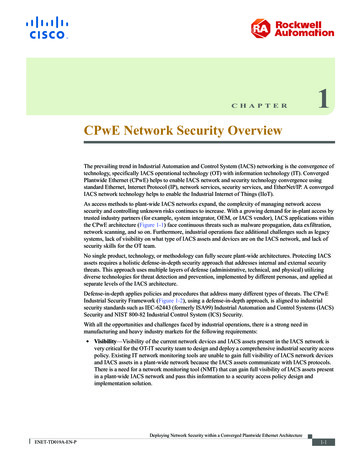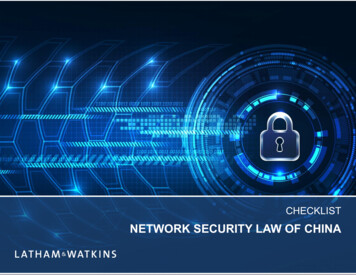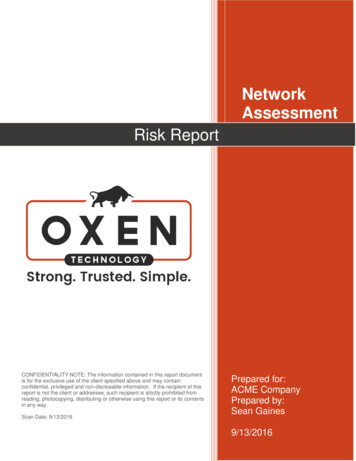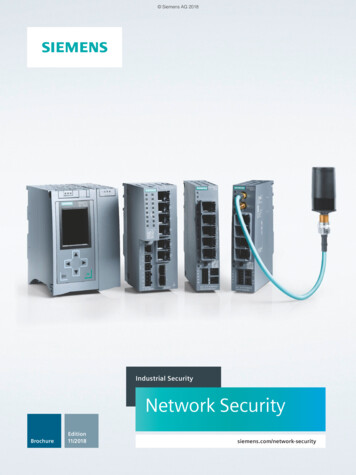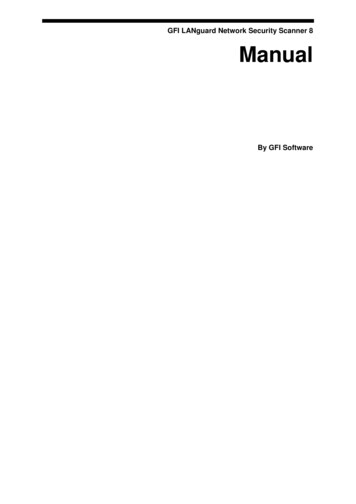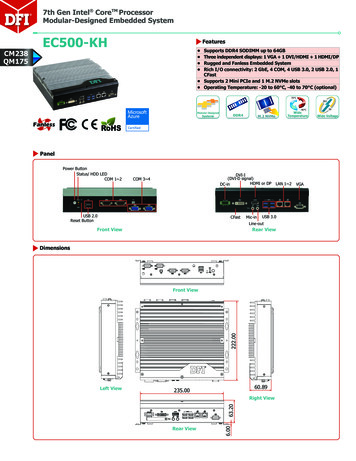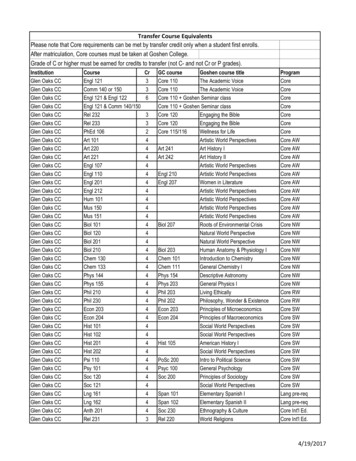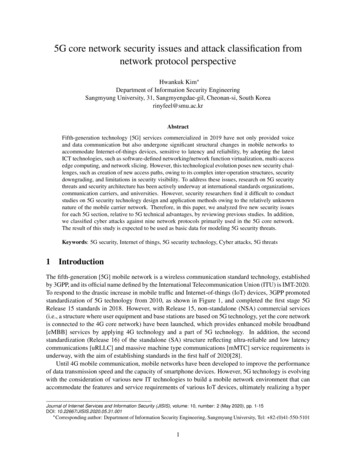
Transcription
5G core network security issues and attack classification fromnetwork protocol perspectiveHwankuk Kim Department of Information Security EngineeringSangmyung University, 31, Sangmyengdae-gil, Cheonan-si, South Korearinyfeel@smu.ac.krAbstractFifth-generation technology [5G] services commercialized in 2019 have not only provided voiceand data communication but also undergone significant structural changes in mobile networks toaccommodate Internet-of-things devices, sensitive to latency and reliability, by adopting the latestICT technologies, such as software-defined networking/network function virtualization, multi-accessedge computing, and network slicing. However, this technological evolution poses new security challenges, such as creation of new access paths, owing to its complex inter-operation structures, securitydowngrading, and limitations in security visibility. To address these issues, research on 5G securitythreats and security architecture has been actively underway at international standards organizations,communication carriers, and universities. However, security researchers find it difficult to conductstudies on 5G security technology design and application methods owing to the relatively unknownnature of the mobile carrier network. Therefore, in this paper, we analyzed five new security issuesfor each 5G section, relative to 5G technical advantages, by reviewing previous studies. In addition,we classified cyber attacks against nine network protocols primarily used in the 5G core network.The result of this study is expected to be used as basic data for modeling 5G security threats.Keywords: 5G security, Internet of things, 5G security technology, Cyber attacks, 5G threats1IntroductionThe fifth-generation [5G] mobile network is a wireless communication standard technology, establishedby 3GPP, and its official name defined by the International Telecommunication Union (ITU) is IMT-2020.To respond to the drastic increase in mobile traffic and Internet-of-things (IoT) devices, 3GPP promotedstandardization of 5G technology from 2010, as shown in Figure 1, and completed the first stage 5GRelease 15 standards in 2018. However, with Release 15, non-standalone (NSA) commercial services(i.e., a structure where user equipment and base stations are based on 5G technology, yet the core networkis connected to the 4G core network) have been launched, which provides enhanced mobile broadband[eMBB] services by applying 4G technology and a part of 5G technology. In addition, the secondstandardization (Release 16) of the standalone (SA) structure reflecting ultra-reliable and low latencycommunications [uRLLC] and massive machine type communications [mMTC] service requirements isunderway, with the aim of establishing standards in the first half of 2020[28].Until 4G mobile communication, mobile networks have been developed to improve the performanceof data transmission speed and the capacity of smartphone devices. However, 5G technology is evolvingwith the consideration of various new IT technologies to build a mobile network environment that canaccommodate the features and service requirements of various IoT devices, ultimately realizing a hyperJournal of Internet Services and Information Security (JISIS), volume: 10, number: 2 (May 2020), pp. 1-15DOI: 10.22667/JISIS.2020.05.31.001 Corresponding author:Department of Information Security Engineering, Sangmyung University, Tel: 82-(0)41-550-51011
5G core network security issues and attack classificationHwankuk K.Figure 1: 3GPP 5G Standardization timeline and Architectureconnected society, which utilizes AI and autonomous vehicles. By providing a faster “mobile communication environment,” where there is no difference between wired and wireless networks in terms ofdata transmission and reception capacity and speed, an “IoT communication environment” can be implemented. Such an environment can offer realistic multimedia content, such as 4K/8K and AR/VR,through new devices, such as AR, VR, drones, and smartphones, while simultaneously ensuring lowpower consumption in IoT devices and stability of services, even in environments where many devicesare connected[27]. ITU-R classified the three major services of 5G mobile network technology into ultrahigh speed and large capacity (eMBB), uRLLC, and mMTC, according to each service requirement, suchas speed, bandwidth, and latency. The technology aims to provide up to 20 times faster speed, 10 timesmore IoT device connections, and 10 times shorter low-latency services than 4G mobile communicationtechnology[11]. We divided the technical features of the 5G network by component (i.e., user device,Table 1: Direction of 5G technological evolutionComponentUser equipment (UE)AccessNetworkCoreNetworkCurrent 4G technologySmartphones and tablets(Voice, text, video, Internet, etc.)Access methodSingle RAT Access (2G, 3G, 4G)(Base Station)Implementationtechnology(Macro cell,femtocell, etc.)Physical deploymentCentralized single core network (EPC)Transmission networkPhysical sharing,providing a single networkEquipment typeInterfaceControl signalFunction modularizationExternal interoperationand applicationsCentralized RANPhysical equipment(PNF, physical network function)Peer-to-Peer I/F architecture(multiple interfaces)CUPS(separation of UP function and CP function)Processing of network computing functionand data storage functions in one placeConnection through the carrier’s core networkand an external GW (SGi, etc.)25G Network (based on SA structure)Accommodation of IoT for B2B business(smartphone, AR/VR, drone, IoT sensors, etc.)Multi-RAT access(including non-3GPP access, such as Wi-Fi)(Ultra-high density small cell)Cloud RAN structure(function division, use of virtualization technology)Distributed cloud-based core network(regional decentralization of core functions)End-to-end network slicing(logical network separation)Virtualization NF (application of SDN/NFV)Service-based I/F architecture (uses HTTP2/RESTful)SDN/NFV-based CUPS acceleration(UPF function distribution and edge redeployment)Stateless network function(separation of network function and data storage)MEC(forward deployment of internal edge network)
5G core network security issues and attack classificationHwankuk K.wireless access network, core network, externally interoperable applications) and summarized them inTable 1(reconstruction based on resources from [28][23][27]). As the main features, 5G techniques selected the software-based architecture, such as cloud-based virtualization technology, network slicing,multi-access edge computing (MEC) support, and service-based interface, by adopting the latest ICTtechnology to achieve the performance goal of 5G services and provide a flexible and scalable mobilenetwork, according to the business-to-business environment.5G security threat modeling must precede the design of the 5G core network security technology, andin this study, we intend to classify the methods of 5G network attacks for security threat modeling. Whileprevious studies mainly analyzed the relationship between protected assets and security threats, this paperis meaningful in that it analyzed security issues related to inter-operated 5G technology characteristicsin detail and classified attack types from the perspective of network protocols.Chapter II describes security threats, according to the evolution of 5G network technologies, byanalyzing the previous studies of 5G security threats. Chapter III classifies the security vulnerabilityissues of mobile networks and the types of network-based cyber attacks that are likely to occur in a 5Gnetwork and describes new protocol security issues of the SA-based 5G core network. Lastly, ChapterIV concludes this paper with a summary of this study and future research direction.22.1New security threats of the 5G networkRelated WorksMajor countries, such as EU, USA, Korea, and China are highly interested in 5G security issues andengage in more fierce competition for the commercialization of 5G services. Therefore, research on 5Gsecurity architecture has been underway at the security working group (WG) of ITU-T SG17, 5G PPP(participation by the European Commission, manufacturers, carriers, service providers, and research institutes), as well as 3GPP, an international standardization organization. 5G Working Group of NextGeneration Mobile Networks (NGMN), led by mobile communication carriers, handles network slicing and MEC security requirements. The European Telecommunications Standards Institute, networkfunction virtualization security (NFV SEC) WG, mainly handles the security specifications of the NFVplatform.With regard to the 5G security standards as a responsibility of 3GPP SA3, discussions on standardsfor security architecture, authentication, network slicing security, and subscriber information protection started in 2016. Security standards (TS 33.501) were announced in August 2018 at 5G Release15[22]. The Release 15 security standards have further strengthened security to address various securityissues discovered in the previous generations. The following was introduced for the improved securityfunction: the International Mobile Subscriber Identity (IMSI) information encryption function to protect subscriber information (IMSI user identifier stored in SIM card, etc.,), Security Edge ProtectionProxy (SEPP) to solve the Signaling System No.7 (SS7) security issues between roaming domains andto implement the application layer security function between different carriers (i.e., public land mobilenetwork) and the integrated authentication framework (i.e., security anchor function (SEAF)), which canuse the same authentication method for 3GPP access and non-3GPP access. SEAF enables devices to bere-authenticated without executing a full authentication method (e.g., AKA authentication), even whenthey move between different access networks or between different service networks[24][17].The European Union Agency for Cybersecurity (ENISA) classified 5G network threat types intoseven categories, in addition to conducting a long-term evolution (LTE) security threat analysis andthen analyzed them as a threat landscape according to the CIA criteria. USA’s 5G America analyzed thepotential security threats by classifying them into UE/Device, radio access network (RAN) section, edge,core, SGi, and interoperation section, through 5G threat surface research[4].3
5G core network security issues and attack classificationHwankuk K.As part of the EU Horizon 2020 project, the 5G PPP “Enablers for Network and System Security andResilience (ENSURE)” announced the 5G security architecture and stressed that various vertical ecosystems on each domain, as well as horizontal domain-specific security, should be taken into consideration;additionally, vertical domain security should be considered for this[21][3].In 2018, the Department for Digital, Culture, Media, and Sport (DCMS) in the United Kingdomannounced the research results on 5G security architecture and security requirements through the 5Gtechnology leading strategy. It emphasized that the protection of networks, systems, and services againstsecurity threats has become increasingly difficult because the 5G environment provides vertical industrialservices by connecting various types of networks and devices, compared to the conventional mobilecommunication environment. The research suggested four considerations, i.e., end-to-end security, layerto-layer security, multi-domain security, and security internalization for the implementation and designof secure 5G architecture[25].Global 5G communication equipment manufacturers, such as Ericsson[5], Cisco [8], and Huawei[9],have also announced security requirements and architecture models according to changes in 5G technology and have commonly suggested requirements for the design of 5G security architecture, such as adistributed cyber attack defense, flexible and scalable security, automation security, and vertical security,as well as security functions on the control plane and user plane presented by the 3GPP security standard.Research on mobile network security vulnerabilities has been active. KAIST University[12] in SouthKorea is a leading group of 4G network security vulnerability research. It developed LTE Fuzzer, whichis a checking tool for LTE security vulnerabilities, and announced a number of security vulnerabilities inthe radio resource control and/or non-access stratum (RRC/NAS) protocol. In 2018, Oulu University[14]in Finland analyzed the requirements of 5G security threats and response solutions. As the key points,it conducted analysis research on 17 security threats that could occur in the 5G environment and security threats for each attack target (i.e., software defined networking (SDN), NFV, and Channel, Cloud).Ferrag of Algeria University[7] conducted research on the classification of 35 security attacks related toauthentication and privacy into 4 categories in the 4G and 5G networks. Xidian University[29] in China,classified 13 security threats by dividing security threats that could occur in the 5G RAN section intophysical, control, and service layers and then analyzed security requirements in terms of CIA and accesscontrol.Global IT companies are also actively conducting research on the development of security technologies, such as a 5G firewall. Positive Technology[19][20], which is a global firm that develops a signalingfirewall for mobile networks, has been conducting research on security vulnerabilities and developingmobile network security technologies for various protocols, such as the GPRS tunneling protocol (GTP),signaling system no. 7 (SS7), and Diameter. Cisco[8]has analyzed 5G security threats that could occur when building a 5G network and conducted research on the development of response technologyproducts.2.2Security issues of 5G network[Figure 2] summarizes the typical security threats for each section centered around the 5G mobile network. In general, over the mobile traffic path, user equipment is connected to application servers of Internet protocol (IP) service networks (Internet service providers, roaming interoperation between countries,etc.) through a radio access network (RAN) and a core network, providing mobile network functions formobility management, authentication, billing, etc. Here, because the 5G network is connected to verticalindustrial networks, such as automobiles, medicine, factories, and IoT devices, as well as the existinglegacy networks (2G, 3G, 4G) and Internet service networks (e.g., SNS, cloud server, etc.), it will createa network connection structure consisting of complex heterogeneous networks, centered around the 5Gnetworks. The complexity of these networks can lead to weak linkages arising from the interconnection4
5G core network security issues and attack classificationHwankuk K.Figure 2: 5G Security Threat Landscapeof networks and devices with different security requirements and different levels of security technologyapplied. Therefore, the biggest security threat is that it can downgrade 5G security. In this section, wedescribe these security issues by classifying them into five categories.2.2.1IoT device security5G technology is expected to handle high-speed large-capacity traffic, 20 times faster than LTE, and thenumber of IoT devices connected to 5G networks is expected to grow by 10 times (1 million per unitarea). The advantage of 5G is that it can establish a hyper-connected environment that provides mMTCservices by allowing a large number of IoT devices to access 5G networks. However, if IoT devicesthat are vulnerable to security management are infected with malicious code, which triggers large-scaledistributed denial-of-service (DDoS) traffic, they may have a direct impact on the 5G network. Accordingto the European ENISA Threat Landscape Report 2018 [26], the size and intensity of DDoS attacks aregrowing at an alarming pace. In 2016, the first case of an IoT devices-related DDoS attack occurred,and in 2018, a terabyte DDoS attack (1.35 TBps) was targeted against the GitHub server; the level of theDDoS attack has been gradually increasing up to 1.7 terabytes.Unlike smartphones, designing common security standards and architecture for IoT devices is noteasy because industry-specific device types (e.g., smart factory devices, smart city sensors, and CCTV),applications, and supply chain ecosystems are diverse and complex. In addition, as the installation of ahigh-level security function for low-end IoT devices is difficult, they are vulnerable to tampering becausethey have weak passwords and old security protection. Therefore, they are more likely to be exposed tovulnerable environments, such as improper access by malicious applications and leakage of subscriberinformation (IMSI) by man-in-the-middle attacks. Hackers may have access to vulnerable IoT devicesand infect them with malicious code to construct a large quantity of IoT botnets and then remotely controlthem through a C&C server to use IoT devices as a means of attack [8].5
5G core network security issues and attack classification2.2.2Hwankuk K.5G RAN securityThe RAN section is composed of various types of base station equipment (macrocell, microcell, femtocell, etc.). The RAN base station equipment is connected to UE through a wireless communicationinterface (i.e., Air Interface) and acts as relay equipment, which connects to the 5G core equipmentthrough a wired transmission network. 5G RAN technology has the advantage of allowing various typesof wireless access technologies to gain access to the 5G network by accommodating not only 3GPPwireless access technologies (i.e., 2G, 3G, 4G) but also non-3GPP access technologies, such as Wi-Fiand wired Internet. However, as various heterogeneous wireless access and mass IoT device access areallowed, protection of the RAN section is critical. To connect mobile communication services, controlsignals (movement, authentication, billing, etc.) are exchanged between the UE and the base station(eNB, gNB) equipment of the RAN section and the communication equipment (MME) of the core network. Here, when abnormal control traffic, due to millions of user devices connected to the RAN basestations, are transmitted and received, resilience issues for failures and strengthening the security of smallcells for home and business, which are easily accessible, are crucial factors.The RAN security threat [24] includes a RAN DDoS attack that requests excessive access to wirelessresources by a huge number of IoT botnets, infected with malicious code, and a jamming attack onwireless signal channels. The base stations transmit and receive abnormal data, owing to RAN DDoSand radio interference jamming attacks, thus resulting in the exhausting of radio interface resources in theRAN section, which ultimately leads to availability issues, preventing normal data reception. Rogue basestation issues allow attackers to launch various types of attacks, such as the interception of user locationinformation, tampering of transmission information, and DDoS attacks between the mobile user and thenetwork through a man-in-the-middle attack, between the mobile UE and the 5G network, using a falsebase station. Rogue base station issues were continuously raised for 2G, 3G, and 4G legacy networks andvarious improvements were applied to the 5G security standards. However, if the distribution of smallscale femtocells is accelerated to resolve the shadow area of wireless mobile communications, roguebase station issues can still be raised in cases where attempts by hackers targeting small cells, for whichsecurity management is relatively neglected, compared to macro base stations, have increased, such asthe security threats of low-end wireless local area networks with the wide spread use of wireless APs.2.2.3Decentralized 5G core architecture securityThe 5G core network adopts a decentralized core network structure. Until the 4G network, a centralizednetwork structure was adopted, in which traffic signals and data transmission paths were centralized ina central office, up to the 4G core network. However, for the local redeployment of the communicationfunction, the 5G network was decentralized by dividing it into a core network and an edge network.Because the path of control plane and user plane traffic is physically separated, the central office mainlyprocesses control traffic, and user data is processed by cloud-based edge communication centers at localoffices. This decentralized core network structure is an efficient structure for providing ultra-low latencyservices and network slicing services. However, because the protection targets are widely and locally distributed, there are security visibility issues which are tightly interconnected between legacy network (2G,3G, 4G networks) devices. Therefore, a decentralized response to cyber attacks is inevitable, resulting ina decentralized response to them from a comprehensive perspective.2.2.4Software-based Infrastructure securityThe 5G network has shifted from hardware-dependent infrastructure to software-based infrastructure[4]. The software-based infrastructure is implemented using 5G communication servers, network equipment, and network slicing services, through SDN and NFV virtualization technology. It provides an6
5G core network security issues and attack classificationHwankuk K.independent network slicing service for each uRLLC, mMTC, and eMBB application service by separating a single physical network into multiple virtual networks. Here, instead of dedicated equipment,the network communication function is implemented on a general-purpose x86 server, in the form of avirtualized SW (i.e., Virtual Machine). However, although virtualization technology, which is the coreof 5G equipment and service implementation, has advantages in terms of resource efficiency, flexibility,and availability, by sharing physical networks and HW server resources (e.g., CPU, memory), it can berelatively vulnerable to load attacks on physically shared HW resources, unauthorized access to networkslicing and shared resources, malicious code distribution through shared resources, and configurationerrors for virtualization management SW [8][24][10][16].(1) SDN/NFV security: SDN technology controls the network delivery function, which has been processed in hardware, by separating the network control function (SDN controller) and traffic delivery function (SDN switch) [5]. Traffic bypass attacks that exploit control protocol vulnerabilitiesbetween SDN controllers and switches, unauthorized access between switches and controllers, andresource depletion of SDN systems by DoS attacks can paralyze services. For example, a saturation attack can occur, which exhausts the SDN switch flow table by attacking SDN controllers.In addition, NFV technology implemented on a general-purpose server has a high possibility ofsecurity issues, unless hypervisor security, malicious VM migration issues, changes or authentication of applications running on virtualized network functionality, and authorization for networkingfunctions are properly controlled. If there is no protection mechanism in place for authenticationand authorization of applications, malicious third party applications can obtain network information from SDN controllers [2][3].(2) Network slicing security: Network slicing is a new technology introduced to the 5G network. It isa virtual network transmission technology that logically separates traffic for each eMBB, uRLLC,and mMTC service, while using the same physical network. Here, if the network slicing for eachservice is not properly separated, there is the possibility of attack from one slice to another. Forexample, an attacker may launch a network slicing resource depletion attack by maliciously overstretching traffic capacity in a network slice dedicated to a specific service, and subsequently, affectother network slices or simultaneously activate specific applications. Without proper encryptionapplied to the network slice, an attacker could eavesdrop or tamper with data belonging to otherslices.2.2.5MEC securityMEC refers to the concept of providing services by constructing an application server inside a mobilenetwork, close to the user’s device, using a method that goes through the existing mobile communicationcore internal network and connects to the application server of the Internet service. The combinationof the 5G network and the concept of edge computing in MEC has the advantage of providing IoTapplications and services, such as telemedicine, autonomous vehicles, factory automation, and IoT sensordata information processing, in real-time without delay. However, because the edge computing server isforward deployed inside the 5G edge network (connected with UPF equipment), a new connection pathcan be created, which leads to security issues.In a mobile network, MEC is implemented through cloud and virtualization technology and is expected to operate in an open system running third party applications. Therefore, MEC systems built intothe internal network of mobile networks can be the main targets of hackers[10]. For example, MEC canbe built as a virtualization platform and MEC applications can run on the same platform as some virtualnetwork functions. If a MEC application is a third party application that is difficult for mobile carriers7
5G core network security issues and attack classificationHwankuk K.to control, it can consume virtualized network resources or obtain access to unauthorized sensitive information with inappropriate application programming interface (API) permissions. Furthermore, there isa risk of providing a new attack path for an attacker, who can attempt to launch an attack on edge network functions, such as UPF, which is distributed 5G network internal equipment, by inserting maliciousapplications[25].3Classification of 5G Core Network Protocol Attacks3.1Security vulnerability issues of the 5G networkTo protect 5G networks and services, security technologies that are different from those of the previousgenerations must be designed, developed, and operated. To establish and operate a safe 5G network,Ericsson[6] derived the security requirements in the stages of standardization, equipment development,network construction, and service operation. Security requirements and security vulnerability issues foreach stage have been summarized in Table x. Because the mobile communication network is composedof a complex ecosystem, it is relatively difficult to solve the associated security vulnerability issues.Table 2: Security requirements and vulnerability issues for each stage to service from standardizationStageSecurity requirementsVulnerability issuesStandardizationDesign of a secure communication protocol fornetwork inter-operationDevelopment of equipment that meets securitylevels required by standardsProtocol Vulnerability (Definition of basic security requirements & specifications)Equipment implementation vulnerability (Different implementations of common function,SW errors, etc.)Network construction vulnerability (Configuration error, Open API, 3rd SW)Operational vulnerability(Vulnerability response, supply chain security)DevelopmentDeploymentOperationDesign and construction of secure networks &servicesDetection and monitoring for cyber attacks,incident response managementFirst, in the standardization stage, communication protocols and interfaces must be designed safelyfor the interoperation of networks and systems between countries. Research on the standards of 5G basicsecurity requirements and architecture has been active by international standards bodies and de-factostandard organizations. 3GPP security standards for authentication and key management for mutualauthentication between users and networks, signaling messages of the control plane, and data protectionof the user plane have been developed to continuously enhance the security of the mobile network.However, because standardization defines the minimum basic security requirements and specifications,there are concerns that vulnerabilities in standard protocols can occur at all times.Second, manufacturers should develop equipment that meets the security standards and target levels required by standards. For example, security vulnerability issues continuously occur in the stage ofequipment implementation because each equipment manufacturer implements different security functions; equipment implemented with SW may contain SW errors or unknown vulnerabilities at the timeof equipment implementation can be found over time. However, when the equipment construction iscompleted, it may take a long time to patch and verify the SW, which leads to supply-chain securityissues.Third, communication carriers must design and build secure networks and services by verifyingsupply-chain products, to ensure that equipment manufacturers’ communication equipment and serviceapplications are implemented to meet security requirements. Nonetheless, configuration setting errorscan be present in the process of building networks and services and security issues by third party applications, not by communication carriers, have been continuously raised.8
5G core network security issues and attack classificationHwankuk K.Lastly, in the final stage of service operation, it is crucial to remove security vulnerabilities againsthighly advanced and intelligent cyber attacks and to restore resilience after cyber breaches. Moreover,the response time required to resolve security issues at each stage can also be a barrier. In other words,because it takes several years to reflect security vulnerabilities of standard protocols in the standardsand it takes approximately 6 months or more for SW patches to provide safety verification to addressequipment implementation vulnerabilities, it is critical to close the security gap between each stage.3.2
ICT technologies, such as software-defined networking/network function virtualization, multi-access edge computing, and network slicing. However, this technological evolution poses new security chal- lenges, such as creation of new access paths, owing to its complex inter-operation structures, security downgrading, and limitations in security visibility. To address these issues, research on .


